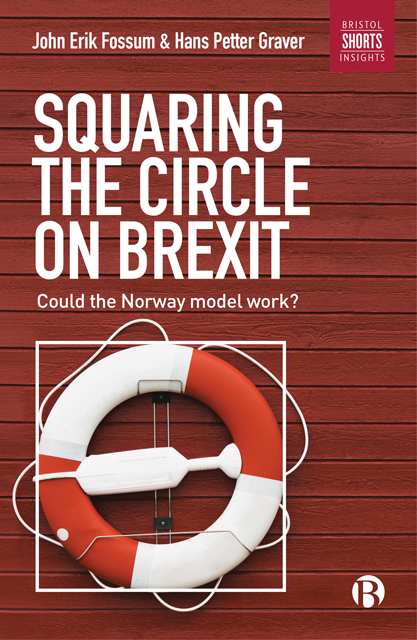Book contents
- Frontmatter
- Contents
- Foreword
- Preface and acknowledgements
- List of abbreviations
- Introduction
- 1 What does Britain want from Brexit?
- 2 Forms of affiliation with non-members
- 3 What is the Norway model?
- 4 The challenge of sovereignty
- 5 What can Britain learn from Norway’s experience?
- 6 Would Britain be an ‘elephant in the boat’?
- Conclusion
- Notes
- References
- Appendix
- Index
Foreword
Published online by Cambridge University Press: 21 April 2023
- Frontmatter
- Contents
- Foreword
- Preface and acknowledgements
- List of abbreviations
- Introduction
- 1 What does Britain want from Brexit?
- 2 Forms of affiliation with non-members
- 3 What is the Norway model?
- 4 The challenge of sovereignty
- 5 What can Britain learn from Norway’s experience?
- 6 Would Britain be an ‘elephant in the boat’?
- Conclusion
- Notes
- References
- Appendix
- Index
Summary
Interest in Norway’s relations with the European Union has intensified since the British referendum in June 2016 and the Brexit process now under way. This book is a timely and welcome contribution to the British and wider European debates.
The European Union has negotiated many agreements with European countries seeking a relationship with it, but unwilling or unprepared to join it. The solution for Norway was found in the European Economic Area which that country shares with Iceland, Liechtenstein and the EU countries.
It is for Norwegians to judge whether the ‘Norway model’ works for them. The British Government has rejected all existing models and seeks something new and unprecedented. The metaphor of choice is ‘bespoke’. Only the outcome of the negotiations will tell us what this means in practice. It is likely to involve compromise and accommodation. In the EEA (and Schengen), Norway is integrated into the EU’s single market regulatory system with a different institutional framework, but is generally perceived to be a ‘rule-taker’ with only limited influence over the making of the rules it takes and applies.
There are complex realities on both sides of the relationship between the United Kingdom and the European Union. The United Kingdom, to adapt the geometrical metaphor of the book’s title, combines a triangular island, Great Britain, with part of the neighbouring island of Ireland. As George Orwell pointed out in 1941: ‘we call our islands by no less than six different names, England, Britain, Great Britain, the British Isles, the United Kingdom and, in very exalted moments, Albion’. The list is a bit outdated, but the point was well made. The United Kingdom is oddly shaped constitutionally. The EU meanwhile is made up of 27 countries, excluding the UK, some of which participate in all of its activities, while others do not. The continent of Europe in the traditional understanding of its geography contains states big and small, UN Security Council members, neutral countries, islands and landlocked states, former colonies, former colonial powers, countries which recently shook off dictatorships, were occupied or occupied others, and so on. The UK is unique in leaving the Union after 45 years as a member, and, while rejecting the various arrangements in place for non-Union countries, has so far been unable or unwilling to articulate a blueprint for its future relationship.
- Type
- Chapter
- Information
- Squaring the Circle on BrexitCould the Norway Model Work?, pp. v - viPublisher: Bristol University PressPrint publication year: 2018

